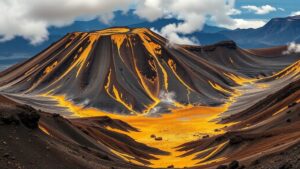The Importance of Hydrothermal Breccias in Locating High-Grade Gold Deposits
The Importance of Hydrothermal Breccias in Locating High-Grade Gold Deposits
Hydrothermal breccias play a crucial role in the exploration and identification of high-grade gold deposits. As a geological phenomenon that results from the alteration of rock due to hydrothermal activity, these breccias are essential indicators of subterranean mineralization processes. Understanding their formation, characteristics, and implications for gold deposits is vital for geologists and mining industries alike.
Understanding Hydrothermal Breccias
Hydrothermal breccias are formed when hot, mineral-rich fluids circulate through pre-existing rock formations, causing fractures and displacements. Over time, these fluids deposit minerals in the broken rock fragments, resulting in a mixture of different rock types–hence the term breccia. The presence of these breccias often signals a zone of mineralization, which is paramount in locating gold deposits.
Formation and Characteristics
The formation of hydrothermal breccias typically occurs in tectonically active environments, where geological processes, such as faulting and volcanic activity, generate pathways for hydrothermal fluids. The key characteristics of hydrothermal breccias include:
- Fragmentation: The rock is broken into angular clasts, often showcasing contrasting mineral compositions.
- Veins and Alteration: Hydrothermal veins filled with quartz or sulfides can often be found, surrounded by altered wall rocks.
- Gold Association: High-grade gold deposits often correlate with the presence of specific alteration minerals, such as sericite and pyrite.
Geological Significance in Gold Exploration
Hydrothermal breccias serve as significant indicators of gold mineralization for several reasons:
- They mark locations where hydrothermal solutions have interacted with host rocks, concentrating gold and other valuable minerals.
- Breccias can often contain higher grades of ore than their surrounding rock due to the focused deposition of minerals.
- The structure of the breccias can influence fluid flow, creating potential traps for gold within the rock formation.
A prime example can be seen in the Carlin Trend of Nevada, USA, a world-renowned gold-producing region where hydrothermal breccias are common. The deposits found here exhibit both high-grade gold and significant quantities of silver, illustrating the potential of hydrothermal breccias as a vector in discovering economically viable mineralization.
Case Studies
Several studies highlight the critical role of hydrothermal breccias in locating significant gold deposits:
- Northparkes Mine (Australia): This copper-gold mine has operations that demonstrate how hydrothermal breccias facilitate mineralization, significantly increasing the ore grades extracted.
- Golden Sunlight Mine (Montana, USA): Here, extensive hydrothermal breccias have led to highly concentrated ore bodies, showcasing the relationship between brecciation and high-grade deposits.
Real-World Applications in Mining
For mining companies and geologists, the exploration of hydrothermal breccias provides actionable insights. Identifying these geological features can guide targeted drilling efforts and reduce exploration costs. Plus, advanced geophysical techniques such as resistivity and electromagnetic surveys can be employed to detect these formations below the surface, enhancing the chances of discovering high-grade gold deposits.
Conclusion and Takeaways
Hydrothermal breccias represent a significant geological feature in the search for high-grade gold deposits. Their structural and mineralogical characteristics provide essential clues that guide exploration efforts. By understanding their formation and implications, geologists can optimize exploration strategies and improve the odds of finding economically viable gold resources. As mining technology evolves, the study and application of hydrothermal breccias will become increasingly important in mineral resource exploration.
In summary, the key takeaways include:
- Recognizing the geological and mineralogical signatures of hydrothermal breccias can lead to successful gold exploration.
- Field studies and real-time data collection enhance the understanding of breccias and their mineralization potential.
- Employing modern exploration techniques can significantly improve the detection and evaluation of hydrothermal systems.

